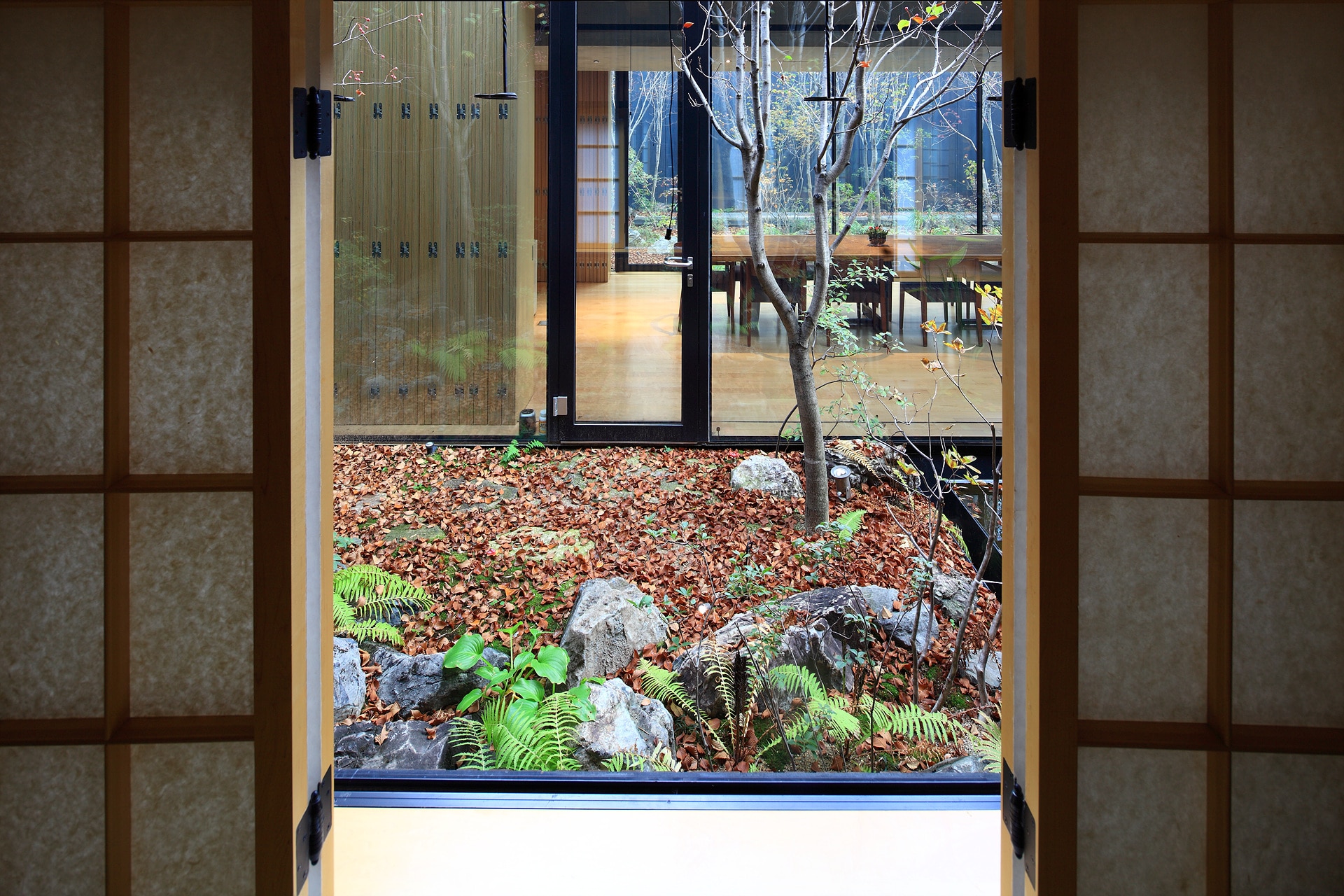Residence ‘Moheon’
| 완공년도 | 2010 |
| 위치 | 대구 |
| 대지면적 | 357㎡ |
| 건축면적 | 120㎡ |
| 연면적 | 164㎡ |
| Mechanical engineer | 세아엔지니어링 |
| Electrical engineer | 우림 전기 |
| Contractor | 삼협건설 |
| Lighting design | 뉴라이트 |
| Landscape | 서안 |
| 완공년도 | 2010 |
| 위치 | 대구 |
| 대지면적 | 357㎡ |
| 건축면적 | 120㎡ |
| 연면적 | 164㎡ |
| Mechanical engineer | 세아엔지니어링 |
| Electrical engineer | 우림 전기 |
| Contractor | 삼협건설 |
| Lighting design | 뉴라이트 |
| Landscape | 서안 |
이 작은 집을 준공할 즈음 건축주 유회장이 이름을 지어줄 것을 요청했다. 즉각적으로 떠오른 단어가 ‘모헌 즉 아무개 집’이란 뜻이다. 이름이 없다는 것이니 존재하지 않는 집이라는 의미였다. 이 집은 이 이름이어야 했다. 이 집은 40년된 기존집의 부속채로서 침실 하나와 정원을 즐기며 식사할 수 있는 사랑채로 구성되었다. 아름다운 정원을 구성하는 게 목적인 이 집은 존재감을 드러내지 않아야 된다고 판단했다. 땅은 100평에 불과하지만 결국 4개의 마당을 만들게 되었다. 앞마당의 면적을 최대로 확보하기 위해 집을 뒤로 물리되 두 개의 레이어를 설정하고 식당으로 쓰이는 앞의 레이어는 투명하게 하여 뒤쪽 레이어인 침실에서도 앞마당이 보이게 했다. 그리고 그 두 레이어를 연결하면서 생긴 두 개의 가운데 마당을 하나는 물의 정원으로 만들고 다른 하나는 선큰시켜 지하층까지 빛이 들어가도록 하였다. 연결 통로에서 보이는 침실의 창 밖에는 굵은 대나무가 심겨져 있는 작은 마당이 보이게 하여 공간의 깊이와 풍요로움을 더했다. 식당의 창 내부는 나무패널의 가변 벽이 있어 필요에 따라 다른 형식의 공간을 만들 수 있지만, 기본적으로 투명한 식당 공간은 대지의 크기를 실제 이상으로 확대시키는 효능이 있었다. 그리고 대지 전체를 집의 높이와 같은 높이의 코르텐 강 담장으로 둘러 위요된 공간의 긴장을 극도로 높이면서 그 비워진 공간을 철저히 강조하였다. 그리고 조경을 맡은 정영선은 불과 9미터 깊이의 50평 크기 마당에 팥배나무를 빽빽이 심고 작고 거친 돌들로 바닥을 매우니 마치 엄청난 크기의 숲 속, 혹은 원시의 자연 같았다. 평소에 보잘것없이 여겼던 팥배나무는 현란한 붉은 색채를 뿌리며 정원을 채웠다. 마술이었다. 건축은 없어지고 조경만 남아야 된다는 나의 기대가 이루어졌다. 전통 한실의 분위기가 농밀한 게스트 룸 대청에 앉아 들창을 열고 가운데 물의 정원과 그 너머, 투명한 식당 공간을 지나서 검은 코르텐 강으로 배경막을 친 돌의 정원이 이루는 풍경은 깊고 풍부하다. 건축이 스스로를 버린 결과일 게다. 감수성 예민한 건축주는 비 오는 소리, 바람 부는 소리, 눈 쌓이는 소리들이 여기에 내려 앉을 때마다, 내게 전화나 문자로 그 감동을 전한다.
When this small house was being completed, the owner, Mr. Yoo, requested a name. The immediate thought was ‘Moheon,’ which means ‘a house that does not exist.’ It signified that the house had no name. The house, a subsidiary building of a 40-year-old existing house, was designed as a reception room with one bedroom and a garden for dining while enjoying the beautiful garden. The main goal was to create a beautiful garden, and it was decided that the house should not assert its presence.
Although the land was only 100 sqm, eventually, four courtyards were created. To maximize the front courtyard’s area, the house was set back, creating two layers. The front layer, used as a dining area, was made transparent so that the backyard, used as a bedroom, could also have a view of the front courtyard. Two central courtyards that resulted from connecting these two layers were turned into a water garden and were elevated to allow light to penetrate down to the basement.
A small courtyard with thick bamboo was planted outside the bedroom window, visible from the connecting corridor, adding depth and richness to the space. Inside the dining room’s windows, there were variable wooden panel walls that could create different spatial configurations as needed. However, the transparent dining area inherently expanded the perception of the site beyond its actual size. The entire site was enclosed by a Corten steel wall of the same height as the house, emphasizing the empty space thoroughly.
Youngsun Jung, who was in charge of landscaping, densely planted azalea trees and covered the ground with small, rough stones in the 50 sqm courtyard that was only 9 meters deep. It resembled a vast forest or primitive nature due to its small size. The azalea trees, which were usually considered unremarkable, filled the garden with vibrant red hues. It was magical.
My hope that only the landscape would remain and the architecture would disappear came true. The atmosphere of a traditional Korean room is rich in the main guest room, where I sit and open the transom window, looking through the transparent dining area and beyond, where a stone garden, backed by a black Corten steel wall, creates a backdrop. It is a deep and rich landscape. The result is that the architecture discarded itself. The sensitive owner of the house conveys his excitement to me through calls and messages whenever rain, wind, or snow settles here.



